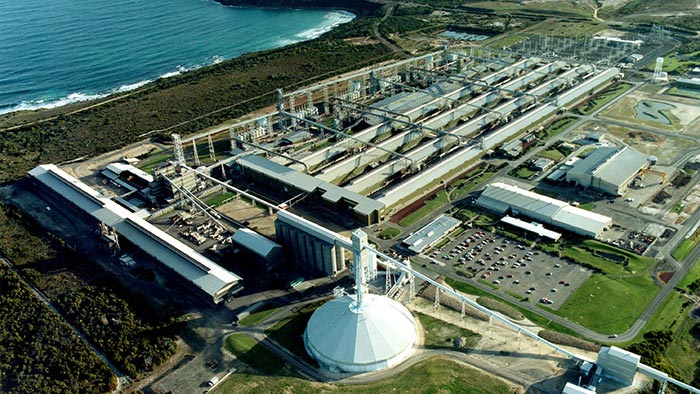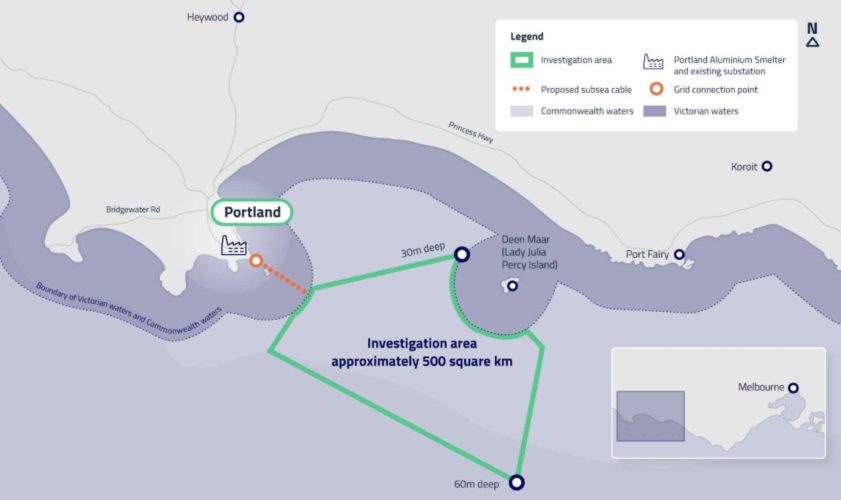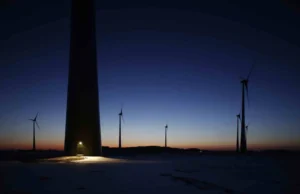Alinta Energy is proposing a 1,000MW wind farm off the coast of Portland in Victoria that could help power the Portland aluminium smelter with up to 100 per cent renewables, and inject green energy into the country’s main grid.
The $4 billion Spinifex offshore wind project, first flagged by Alinta CEO Jeff Dimery in an interview on RenewEconomy’s weekly Energy Insiders podcast in October, would be sited about 10km off the coast of Portland.
Spinifex would connect to the grid via the smelter’s switchyard – which accounts for more than 10 per cent of the state’s electricity demand – and make the site among Australia’s first smelters to be powered by up to 100 per cent renewables.
Portland currently sources its electricity under contracts from coal generators, including like most other big energy users in Australia. Earlier this year it signed a new five year deal with AGL, Origin and Alinta for its subsidised electricity supply, which also included an agreement to act like a giant battery.
But aluminium smelters in Australia and around the world are under pressure – mostly from customers – to deliver low or zero carbon products, and may face border tariffs in the future if they don’t.
Australia’s other major aluminium smelters, at Tomago in NSW and Boyne Island in Queensland, are already committed to switching to a 100 per cent renewable energy supply by the end of the decade under plans by owner Rio Tinto to invest in more than 7GW of wind and solar.
Alinta believes that the Spinifex project will need to be sized at around 1,000MW to make it commercially viable, and it points out that the project is still in its very early stages, with the exact location and turbine size yet to be determined.
Spinifex is one of more than a dozen proposed offshore wind projects in Australia – which can now move forward following the passage of legislation permitting such projects – but is the first to identify a major customer, which may enable it to leapfrog other proposals.
“Existing data suggest Portland Bay has an excellent wind resource that would be suitable to power offshore wind turbines,” said Kris Lynch, Alinta Energy’s head of project development.
“What we’re doing now is deploying monitoring equipment to ensure that’s also the case across the investigation area.
“We’re sharing the news at this early stage because we want to be able to speak openly with everyone as our initial investigations progress,” he said.
Portland is a joint venture between Alcoa, Citic and Marubeni, and smelter manager Ron Jorgensen said the “exciting” offshore wind proposal, aligned with the aluminium industry’s direction to decarbonise, and would help improve the long term viability of the smelter.
“This proposal offers an ability to make a step change impact to Portland Aluminium’s carbon footprint and we welcome the opportunity to be involved in supporting the early phase investigations of a such an exciting renewable project on the Australian energy landscape,” he said in a statement.
Lynch told RenewEconomy that it could take up to 10 years to deliver the offshore wind farm, which will likely feature massive turbines. The latest are sized around 15MW, but this could grow over coming years in the race for size and efficiency.
Offshore wind is currently more expensive than other renewable energy sources, such as solar PV and onshore wind, but its costs are coming down fast, thanks to the sheer scale of the turbines.
“We know that we’ve got a really strong wind resource in the Portland area,” Lynch told RenewEconomy.
“And so if we can get the high capacity factors that we think we’re going to get, we think that we can come up with an affordable product that’s going to be well suited to the smelter.” The proximity to the smelter, and the major customer, will also help the economics.
The $4 billion price tag will be huge for a company even of Alinta’s size. How exactly it will be funded has yet to be determined, and it’s not yet clear if Alcoa will take an equity share in the project, or if government funding will be needed or sought.
See RenewEconomy’s updated Offshore Wind Farm Map of Australia
Good, independent journalism takes time and money. But small independent media sites like RenewEconomy have been excluded from the millions of dollars being handed out to big media companies from the social media giants. To enable us to continue to hold governments and big business to account on climate and the renewable energy transition, and to help us highlight the extraordinary developments in technology and projects that are taking place, you can make a voluntary donation here to help ensure we can continue to offer the service free of charge and to as wide an audience as possible. Thank you for your support.











